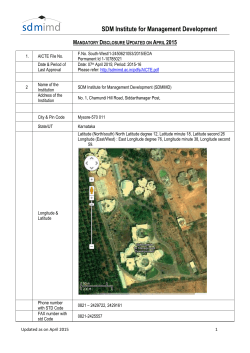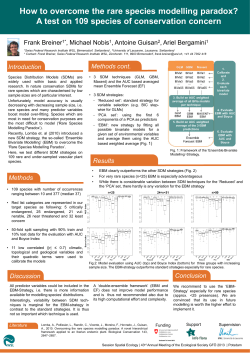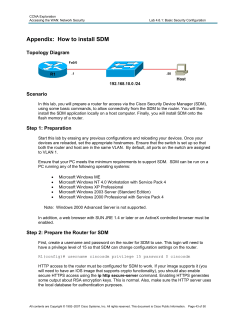
WS1 SDM: How to migrate from point‐to‐point transmission to full optical networking?
WS1 SDM: How to migrate from point‐to‐point transmission to full optical networking? Georgios Zervas Periklis Petropoulos Yoshinari Awaji Hidehiko Takara University of Bristol, UK ORC, UK NICT, Japan NTT, Japan Network Traffic Growth Network traffic growth rate: 2 dB/year R.-J. Essiambrie & R. W. Tkach, Proc. IEEE, pp. 1035-1055, 2012.1 … Moore’s Law for ever … ? 1E 1P 6T x108 x107 Practical fibre limit 20-30 Tbit/s, fibre @ 1 bit/Hz x106 x105 x104 100 times capacity increase every 10 Years 10P 100T 60G 100 T 1+ T 600M x103 x102 x10 x1 1T 15G 6M Trunk Metro Access Courtesy of Per O. Andersson 10G 155 M 64k 2000 2005 2010 2015 2020 2025 2030 2035 2040 Achieved Single Mode (Single-Core) Fiber Capacity We are reaching the capacity limit of single mode fibers (C + L bands) Transmission System capacity (Tb/s) 1000 TDM Research WDM Research 100 10 1 0.1 0.01 0.001 1980 1985 1990 1995 2000 Year 2005 2010 2015 2020 Rapid Progress of SDM 10 times increase in transmission capacity achieved with SDM in couple of years Courtesy of Transmission System capacity (Tb/s) 1000 100 TDM Research WDM Research SDM Research 10 1 0.1 0.01 R.-J. Essiambre and R. W. Tkach 0.001 1980 1985 1990 1995 2000 Year 2005 2010 2015 2020 Existing technologies: Fibers & Amplifiers • Fibers • • • Multi-Core Fibers (7-core, 12-core, 19-core), Multi-Element Fibers (3-element, 7-element) Few /Multi Mode Fibers Vortex fibers (Orbital Angular Momentum) - N. Bozinovic, et.al, Th.3.C.6 ECOC2012 305 Tb/s Sakaguchi et al., OFC 2012 PDP5C.1 • 1 Pb/s H. Takara, et.al., PD, ECOC 2012 , Th.3.C.1, Amplifiers • • Multi-Core EDFAs • 7-core has been commercialized • Erbium-doped multi-element fiber (MEF) amplifiers Few/Multi-Mode EDFA S.Jain, et.al., Optics Letters, Vol.38(4) ,2013 Existing technologies: Tx/Rx • Transceivers - Maintain advantages of SDM at the end point • Tx • Multi-core fiber DFB lasers (P.S. Westbrook, Vol 37 (19), Optics Letters, 2012) • Optical Vortex Emitters for OAMs (Xinlun Cai et al.Science,Vol. 338, 363 (2012).) • • Rx • • • … Silicon Photonics Core-, Wavelength-, and Polarization-Diversity Receiver (C.R. Doerr, IEEE PTL, Vol. 23 (9), 2011) … Transceivers • Arrays of VSCELs and PD for Multi-core (4 Fiber – 6-Core/Fiber) (Lee et al., JLT, 30 (6), pp. 886-892, 2012 ) • • … Applied for 1Tbps high density, low power I/Os for Supercomputers/ Data Centers (footprint is very important) Existing technologies: Mux/Demux • Multiplexers/De-multiplexers (e.g. Core Mode Mux/demux) • • • Free-space Core mux/demux (7-core, 19-core) Waveguide-based MCF mux-demux … W. Klaus et al., IEEE Summer Topicals 2012, WC3.3. H. Takara, et.al., Th.3.C.1, PostDeadline, ECOC 2012 Thomson et al. Optics Letters, 37(12), p2331 (2012) Switching technologies for SDM networking Switching • • • At core level using MCF-SMF MUX/DEMUXes At MCF level in conjunction with Frequency switching λ Maintain MCF benefits at switching level - need to do lots more • • AoD Node Any and as many spatial channel switching New ROADM archs that address MCF and scalability λ Core Core λ Mul$core MEMS cross‐connec$ons Fibre 1 1 1 2 PLZT 1 1 2 2 2 3 SDM DEMUX Mul$core Fibre 3 1 λ1λ2 1 SSS SP‐1 EDFA‐1 Spli9 er • λ 1 4 SDM MUX SDM/FDM/TDM Switching and Networking Using MCF and Mux/Demuxes (Amaya, ECOC PDP 2012, OFC 2013) 7cores x (1x2) SDM-WSS , OFC PDP 2013f How to migrate towards SDM networking and deliver bandwidth at minimum cost? • Deliver SDM devices/systems/functions across the network … • Deliver SDM nodes that scale and are flexible enough to support spatial dimensions in addition to frequency and …. • Deliver a control/management system (e.g. SDN) that considers • • • • SDM particularities (e.g. crosstalk, mode coupling, selfhomodyne transmission, etc. ) …, minimized complexity aids migration delivered at low cost !!! Questions I • What are/will be the key SDM benefits with regards to Multi‐Fiber networks? • When and where (metro, backbone, data centers) will it make sense to deploy? • • • Cost Space Energy High Performance Computing Data Centers • If SDM, which technology has the best chances for Network deployment ? • • • • Multi‐Core/Multi‐Element Fibers Few/Multi‐Mode Orbital Angular Momentum … Questions II • Where will SDM appear first ? • • Fiber‐poor Telco operators Data Centers (Intra – Inter) • What about SDM switching node scalability ? • Do the current ROADM architectures scale to support SDM? • E.g. 5‐degree node with 12‐core fibers requires 1x60 WSS • As capacity increase will we still need wavelength switching on every link/node ? • • • • Metro/Aggregation with wavelength switching ? Inner‐core network with Space switching ? What are the benefits and challenges of SDM for network control and virtualization? What would be the tipping‐point (e.g. Price) to SDM networks and when? Workshop Agenda 15 mins / talk incl. questions Session 1: 14:00 – 15:30 ‐ Chair: Periklis Petropoulos (ORC, UK) 1. Recent progress in SDM transmission technologies and perspectives for optical networking Toshio Morioka, DTU (Denmark) 2. High capacity MCF transmission technology for future optical transport networks Akihide Sano, NTT (Japan) 3. Key technologies and requirements for space division multiplexing (SDM) networks Takehiro Tsuritani, KDDI (Japan) 4. Optical nodes for SDM networking: challenges and possible approaches Norberto Amaya, University of Bristol (UK) 5. Multi‐dimensional spatial‐spectral switching network nodes. Dan Marom, The Hebrew University of Jerusalim, (Israel) Workshop Agenda 15 mins / talk incl. questions Session 2: 16:00 – 17:30 – Chair: Hidehiko Takara (NTT, Japan) 6. IBM SDN‐VE: Software Defined Networking for Virtual Environment Rami Cohen, IBM (Israel) 7. Exploiting SDM benefits in optical networks. Jun Sakaguchi, NICT (Japan) 8. SDM: What’s It Worth to You? – Scenarios for Price‐Points of Components of Multi‐Core Fiber Systems. Steven Korotky, Alcatel‐Lucent (USA) Panel Discussion @ 16:45 – Moderator: Yoshinari Awaji (NICT, Japan) • WDM was a great success! • From lab demonstration to commercial use in less than 10 years • Is SDM going to repeat the WDM success story? • When and where are we going to use it? • Why not Multi‐Fiber Networks ? This workshop will discuss the following questions • Which is the most suitable SDM technology for networking? – Is it there one optimum technology for every domain (backbone, access, Data Centre) ? • What are the benefits and challenges of using SDM in networks? • How do the different SDM alternatives compare when considered for backbone, metro/access and HPC / data‐centre networking?
© Copyright 2025













